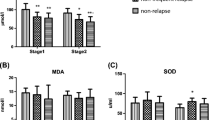Abstract
Background
The role of idiopathic nephrotic syndrome (INS) in the pathogenesis of atherosclerosis in childhood has not been clearly elucidated. However, antioxidative defense in INS is thought to be imbalanced. This study aimed to assess the changes of plasma concentration of selected aminothiols in the blood of children with INS at various stages of the disease.
Methods
This cross-sectional study was conducted in 125 children aged 2-18 years. The children were divided into 4 groups: group A, early relapse (n=37); group B, early remission for 4-6 weeks from the onset (n=37); group C, late steroid-free remission (n=31); and group D, long-term remission for 2-5 years (n=20). Control group (E) consisted of 30 age- and gender-matched healthy children. The study protocol comprised an analysis of plasma concentrations of glutathione, homocysteine, cysteine and cysteinylglycine by high-performance liquid chromatography. Fractions of protein-bound and free aminothiols were measured. Endothelial injury was assessed by thrombomodulin, PAI-1 concentration, and von Willebrand factor activity.
Results
The children with INS had unbalanced aminothiol metabolism only in relapse and early remission, that shifted towards increased oxidative processes. Administration of cyclosporine A caused a significant increase in homocysteine and cysteine concentration. Changes in aminothiol metabolism were significantly related to endothelial injury.
Conclusions
The findings of this study may be helpful in elucidating the pathogenesis of premature atherosclerosis in patients with INS refractory to the treatment or in the case of frequent relapse.
Similar content being viewed by others
References
Lechner BL, Bockenauer D, Iragorri S, Kennedy TL, Siegel NJ. The risk of cardiovascular disease in adults who have had childhood nephrotic syndrome. Pediatr Nephrol 2004;19:744–748.
Edefonti A, Lilova M. Complications of the nephrotic syndrome. In: Cochat P, eds. ESPN Handbook 2002. Lyon: Medcom, 2002: 251–254.
Turi S, Nemeth I, Torkos A, Saghy L, Varga I, Matkovics B, Nagy J. Oxidative stress and antioxidant defense mechanism in glomerular diseases. Free Radic Biol Med 1997;22:161–168.
Fydryk J, Olszewska M, Urasinski T, Brodkiewicz A. Serum selenium level and glutathione peroxidase activity in steroidsensitive nephrotic syndrome. Pediatr Nephrol 2003;18:1063–1065.
Zachwieja J, Bobkowski W, Dobrowolska-Zachwieja A, Zaniew M, Maciejewski J. Decreased antioxidant activity in hypercholesterolemic children with nephrotic syndrome. Med Sci Monit 2003;9:235–239.
Warwick GL, Waller H, Ferns GA. Antioxidant vitamin concentrations and LDL oxidation in nephrotic syndrome. Ann Clin Biochem 2000;37:488–491.
Granqvist A, Nilsson UA, Ebefors K, Haraldsson B, Nystrom J. Impaired glomerular and tubular antioxidative defense mechanisms in nephrotic syndrome. Am J Physiol Renal Physiol 2010;299:898–904.
Khalil A, Mandal K, Khalil S, Mallika V. Homocysteine, fibrinogen and lipid profile in children of young adults with coronary artery disease. Indian Pediatr 2011;48:156–157.
Yi F, Li PL. Mechanisms of Homocysteine-Induced Glomerular Injury and Sclerosis. Am J Nephrol 2008;28:254–264.
International Study of Kidney Diseases in Children. Primary nephrotic syndrome in children: Clinical significance of histopathologic variants of minimal change and of diffuse mesangial hypercellularity. Kidney Int 1985;20:765-777.
Wyszynska T, Litwin M, Ksiazek J, Borowski A, Jarmolinski T. Zespól nerczycowy. In: Sieniawska M, Wyszynska T, eds. Nefrologia dziecieca. Warszawa: OIN "Polfa", 2003: 253–313. [In Polish]
Chwatko G, Bald E. Determinination of different species of homocysteine in human plasma by high-performance liquid chromatography with ultraviolet detection. J Chromatography 2002;949:141–151.
Schwartz GJ, Munoz A, Schneider MF, Mak RH, Kaskel F, Warady BA, et al. New equations to estimate GFR in children with CKD. J Am Soc Nephrol 2009;20:629–637.
Tkaczyk M, Czupryniak A, Nowicki M, Chwatko G, Bald E. Homocysteine and glutathione metabolism in steroid-treated relapse of idiopathic nephrotic syndrome. Pol Merkur Lekarski 2009;26:294–297.
Kaneko K, Kimata T, Takahashi M, Shimo T, Tanaka S, Tsuji S. Change in urinary 8-hydroxydeoxyguanosine in idiopathic nephrotic syndrome. Pediatr Nephrol 2012;27:155–156.
Mishra OP, Gupta AK, Prasad R, Ali Z, Upadhyay RS, Mishra SP, et al. Antioxidant status of children with idiopathic nephrotic syndrome. Pediatr Nephrol 2011;26:251–256.
Markan S, Kohli HS, Sud K, Ahuja M, Ahluwalia TS, Sakhuja V, et al. Oxidative stress in primary glomerular diseases: a comparative study. Mol Cell Biochem 2008;311:105–110.
Dwivedi J, Sarkar PD. Study of oxidative stress, homocysteine, copper & zinc in nephrotic syndrome: therapy with antioxidants, minerals and B-complex vitamins. J Biochem Tech 2009;1:104–107.
Aminzadeh MA, Gollapudi P, Vaziri ND. Effect of nephrotic syndrome on homocysteine metabolism. Nephrol Dial Transplant 2011;26:1244–1247.
Tenderenda E, Korzeniecka-Kozerska A, Porowski T, Wasilewska A, Zoch-Zwierz W. Serum and urinary homocysteine in children with steroid-dependent nephrotic syndrome. Pol Merkur Lekarski 2011;31:204–208. [In Polish]
Arnadottir M, Hultberg B, Berg AL. Plasma total homocysteine concentration in nephrotic patients with idiopathic membranous nephropathy. Nephrol Dial Transplant 2001;16:1720–1721.
Dogra GK, Irish AB, Watts GF. Homocysteine and nephrotic syndrome. Nephrol Dial Transplant 2001;16:1720–1721.
Bafna A, Sarkar D, and Bafna S. Study of homocysteine, total antioxidant capacity, lipoprotein (a) and minerals in steroid sensitive nephrotic syndrome. Int J Biol Med Res 2011;2:536–538.
Tkaczyk M, Czupryniak A, Lukamowicz J, Fendler W, Bald E, Chwatko G. The impact of cyclosporine A administration on aminothiols concentration in nephrotic children. MONZ 2013;19:59–63.
Zoja C. Cyclosporin-induced endothelial cell injury. Lab Invest 1996;55:455–462.
Tkaczyk M, Czupryniak A, Owczarek D, Lukamowicz J, Nowicki M. Markers of endothelial dysfunction in children with idiopathic nephrotic syndrome. Am J Nephrol 2008;28:197–202.
Paisley KE, Beaman M, Tooke JE, Mohamed-Ali V, Lowe GD, Shore AC. Endothelial dysfunction and inflammation in asymptomatic proteinuria. Kidney Int 2003;63:624–633.
Rustom R, Leggat H, Tomura HR, Hay CR, Bone JM. Plasma thrombomodulin in renal disease: effects on renal function and proteinuria. Clin Nephrol 1998;50:337–341.
Pelkowska A, Sancewicz-Pach K. Determination of endothelial function in children with nephrotic syndrome in various states of disease. Wiad Lek 2005;58:35–38.
Author information
Authors and Affiliations
Corresponding author
Rights and permissions
About this article
Cite this article
Tkaczyk, M., Miklaszewska, M., Lukamowicz, J. et al. Blood concentration of aminothiols in children with relapse of nephrotic syndrome. World J Pediatr 12, 353–359 (2016). https://doi.org/10.1007/s12519-016-0028-8
Received:
Accepted:
Published:
Issue Date:
DOI: https://doi.org/10.1007/s12519-016-0028-8




